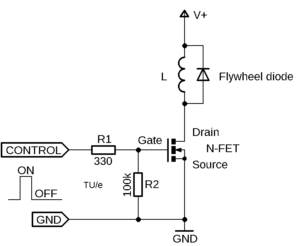A solenoid converts an electrical current directly into linear a mechanical motion. It is therefore related to a relay. Wire wound as a coil acts as an electromagnet when current is passed through it. Inside the coil body there is a so called plunger, performing the mechanical action. Activated by the electrical current. The plunger (armature) can move freely though the inside of the coil. Activating the coil will pull the plunger inside the coil towards the stop. As the magnetic field is the strongest in the center of a coil. Most of the solenoids are based on this principle of pulling the plunger. Even the ones sold as pull action are. But than the plunger has an extension on one side of the plunger, a narrow rod that comes out of the frame on the other side. Allowing for a push action, also called thrust. Some solenoids have mechanical springs to support the plunger when moving outside the coil as the current is switched off. Others have permanent magnets to hold the plunger fixed in a state, this is called latching. After activating the coil, the current can be switched off, ideal for battery operated devices. The current through the coil needs to be reversed to get an opposing magnetic field (neutralizing the one from the permanent magnet) to release the plunger in a latching solenoid. Still needing a small external force to retract the plunger to the open position. Most solenoids have two mechanical switching states (positions) on/off or better energized or non energized. But also proportional solenoids exist. There the amount of current controls the magnetic field strength, that again controls the variable (proportional) plunger positioning. This principle is used for controlling pressure or flow rate of fluids or gases e.g. fuel injection in a combustion engine.
Specifications
- Pull or push/thrust action or even rotating.
- Stroke length (mm).
- Force required (N).
- Operating voltage (V).
- Power rating (Watt). E.g. 3W @100% Duty cycle (on all the time) Or 6W @50% duty cycle.
- Latching or non latching.
Warnings:
When a solenoid is powered, it will warm up. This causes the coil resistance to increase, reducing the current and therefore the force. So, more heat results in less force. Overheating can damage the solenoid-bobbin and permanently obstruct the plunger movement. A practical solution to overcome overheating is: Start activating the solenoid with 100% duty cycle for a short amount of time. This will move the plunger in the desired position firmly. Then reduce the duty cycle to a much lower value, like 60% or so (PWM). Actual values are depending on the solenoid specs and the holding force you need in your application. Holding force; once the plunger is in the desired position you need a much lower force to keep it there, compared to the force needed to actually move it there. Latching solenoids have a permanent magnet to keep the plunger in the activated position. Therefore they consume less energy but need a more complicated control circuit. As you need to reverse the coil polarity.
The solenoid coil acts like any induction, so when activating it with a semiconductor (transistor, FET) you will need a flywheel diode for protecting this semiconductor. See the links for more detail.
Applications
Door holding magnets. Ding Dong door bell. Activating switches. Locking mechanisms. Solenoid valves that control water or air inlets.
